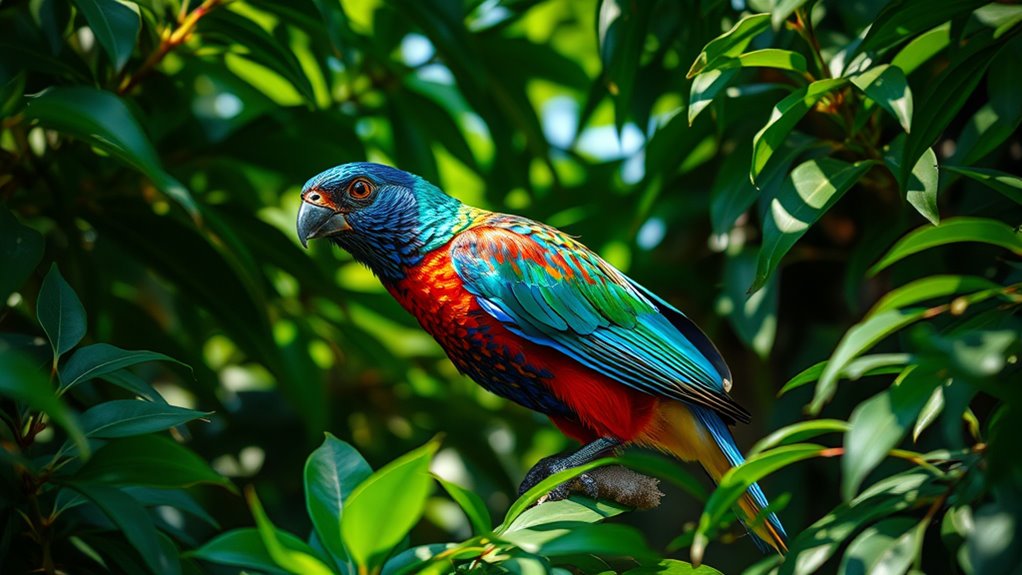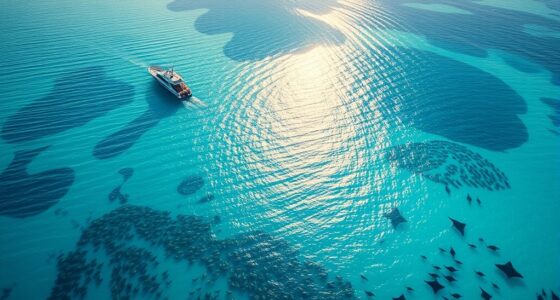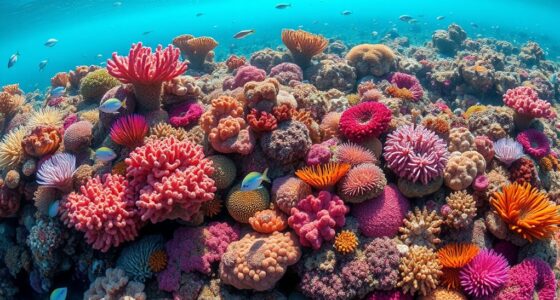Discovering a bird thought extinct for 170 years in Indonesia is a remarkable event, showing that nature’s resilience can surprise us. This rediscovery confirms the importance of conservation efforts and highlights Indonesia’s rich ecosystems, which often remain unexplored. It also demonstrates how technology, like AI, supports species monitoring and habitat protection. If you want to learn more about this inspiring find and what it means for conservation, keep exploring the details behind this extraordinary event.
Key Takeaways
- The rediscovery confirms the bird was not extinct, providing hope for conservation and ecological recovery.
- Indonesia’s rich ecosystems continue to harbor undiscovered or thought-to-be-lost species.
- Advanced technology, including AI security, aided in locating the species after 170 years.
- The finding underscores the importance of habitat preservation and combating threats like deforestation.
- Community involvement and ongoing research are vital for protecting this species and its environment.

Scientists have confirmed the rediscovery of a bird once thought to be extinct in Indonesia, offering hope for conservation efforts and new insights into the region’s biodiversity. This remarkable find underscores how much remains hidden in Indonesia’s rich and often unexplored ecosystems. It also highlights the importance of ongoing conservation efforts aimed at protecting vulnerable species and their habitats. The rediscovery sparks a renewed sense of hope among conservationists, scientists, and local communities, reminding us that even species believed lost can sometimes be found if we remain vigilant and committed.
A rediscovered bird in Indonesia offers hope and highlights the importance of protecting hidden biodiversity.
As you explore this discovery, you’ll realize the ecological significance of this bird’s return. Its presence can influence the surrounding ecosystem in ways that benefit other species and promote overall ecological balance. Every species plays a role in maintaining healthy habitats, whether through seed dispersal, pest control, or other ecological functions. Recognizing the importance of such species encourages more thorough conservation efforts, not just to protect individual birds but to safeguard entire ecosystems. Preserving habitat connectivity and reducing threats like deforestation or illegal hunting become even more essential when a rediscovery like this occurs, as it demonstrates the resilience of nature and the importance of maintaining healthy environments. This event also highlights the critical role of AI security technologies in supporting conservation initiatives by enabling better data collection and threat monitoring.
This rediscovery also serves as a reminder that Indonesia’s biodiversity is still incompletely documented. Many species remain unknown or under threat, and each discovery emphasizes the need for continued research and habitat protection. You might feel inspired to support conservation initiatives, understanding that every effort counts toward safeguarding these irreplaceable natural treasures. The ecological importance goes beyond the bird itself—it symbolizes the potential for recovery and the importance of maintaining biodiversity for future generations. Additionally, community involvement can significantly enhance conservation success by fostering local stewardship and awareness. The find can motivate governments, conservation organizations, and local communities to prioritize habitat preservation and sustainable practices to ensure species like this bird can thrive once more. Recognizing biodiversity conservation as a crucial goal can lead to more effective policies and community-driven actions.
In practical terms, this rediscovery calls for increased funding, research, and community engagement. It highlights the urgency of protecting Indonesia’s unique habitats, which are often threatened by logging, agriculture, and infrastructure development. Your awareness of these issues can contribute to advocacy and support for policies that promote ecological sustainability. Additionally, utilizing low light office plants can help improve indoor air quality in research facilities or conservation offices involved in such efforts. Ultimately, this rediscovery reminds us that nature still holds surprises, and with continued effort, we can help restore and preserve the ecological integrity of regions like Indonesia. Your involvement, whether through education or activism, can play a necessary role in ensuring that such species are protected and remain a crucial part of Indonesia’s natural heritage.
Frequently Asked Questions
What Specific Habitat Within Indonesia Was the Bird Found?
You might wonder where this elusive bird was found in Indonesia. It was discovered in a remote, pristine rainforest habitat, which highlights the importance of habitat preservation. To protect such species, ongoing bird monitoring is essential, ensuring that we can detect changes and act swiftly. Preserving these critical ecosystems helps maintain biodiversity and prevents further extinctions of rare or thought-to-be-extinct birds like this one.
How Was the Bird Rediscovered After so Many Years?
Imagine witnessing a miracle—you’re part of the team that rediscovered a bird thought lost forever! You use advanced technology and meticulous habitat preservation efforts to identify the species. By carefully studying its unique features and habitat, you confirm its identity. This breakthrough highlights the importance of protecting ecosystems, ensuring this incredible species remains safe for future generations. Your discovery proves hope and perseverance can bring the impossible back to life.
Are There Conservation Plans for This Rediscovered Species?
You should know that conservation plans for this rediscovered species focus on habitat preservation and ecotourism development. By protecting its natural environment, you help guarantee its survival and promote sustainable tourism that benefits local communities. These efforts aim to create a balanced approach, allowing the bird to thrive while also increasing awareness and funding for ongoing conservation. Your support in these initiatives can make a real difference in securing its future.
What Distinguishes This Bird From Similar Extinct Species?
You can distinguish this bird from similar extinct species through unique features revealed by species identification, such as specific plumage patterns and vocalizations. Its evolutionary significance lies in understanding its lineage and adaptations that survived over time. Recognizing these traits helps scientists trace its history, offering insights into evolutionary processes. This discovery emphasizes the importance of detailed analysis for accurately identifying extinct species and appreciating their role in biodiversity.
Could This Rediscovery Impact Local Ecosystem Balance?
Imagine the ripple effects this rediscovery could cause—you might realize it’s more than just a rare sighting. The ecological implications are profound; this bird could restore some balance to its habitat. However, it also brings conservation challenges, as protecting it requires careful planning. Your actions now could influence the ecosystem’s future, making this find a catalyst for renewed efforts to preserve biodiversity and address environmental concerns.
Conclusion
You’ve just witnessed how hope can spring eternal, even after more than a century and a half. The rediscovery of this bird proves that sometimes, nature still has surprises up its sleeve. It’s a reminder not to count out the impossible, because miracles can happen when you least expect them. Keep your eyes open and stay curious—who knows what other hidden treasures are waiting to be found in the wild?









